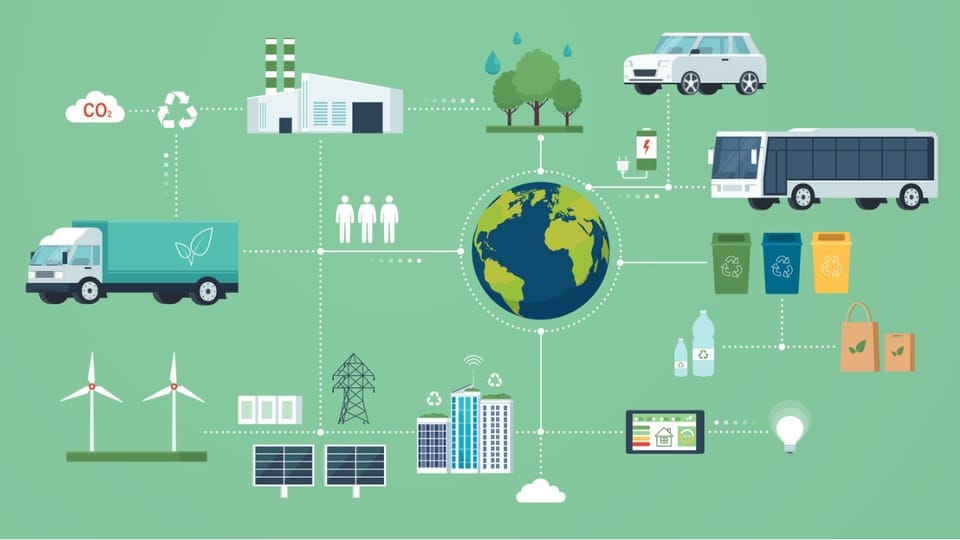Building a Greener Supply Chain: The Future of Sustainable Logistics

Building a Greener Supply Chain: The Future of Sustainable Logistics
Introduction
As global awareness of environmental challenges grows, the demand for sustainable practices in every industry is intensifying. Supply chain and logistics, a sector with a substantial carbon footprint, have a unique opportunity to make a positive impact. At Linkedlogi, we recognize that building a greener supply chain isn't just a trend—it's the future of sustainable logistics. Here’s how we’re approaching this challenge and what the broader industry can learn.
1. The Need for Sustainable Logistics
The logistics industry accounts for a significant share of global carbon emissions, primarily due to transportation, warehousing, and inefficient supply chain practices. With increasing consumer demand for eco-friendly products and services, businesses must adapt to sustainability trends or risk being left behind.
Key Drivers of Change:
- Consumer Awareness: Eco-conscious consumers prefer brands with a clear commitment to sustainability.
- Regulations: Governments worldwide are introducing stricter environmental regulations, pushing companies to adopt greener practices.
- Cost Savings: Sustainable logistics often lead to cost efficiencies, such as reduced fuel consumption and optimized routes.
2. How Linkedlogi is Paving the Way
At Linkedlogi, we're integrating sustainability into our logistics solutions through innovative technology, smart practices, and partnerships that prioritize the environment. Here’s how:
a. Optimized Route Planning
Our AI-driven algorithms enable more efficient route planning, reducing fuel consumption and emissions. By leveraging machine learning, we can adapt routes in real-time, minimizing delays and unnecessary detours.
b. Efficient Load Management
Our platform ensures that trucks, ships, and other transportation modes are utilized to their full capacity. This reduces the number of trips needed, thereby cutting emissions and fuel costs.
c. Green Partnerships
Linkedlogi collaborates with logistics providers that prioritize sustainability. From using energy-efficient vehicles to incorporating renewable energy sources, we ensure our partners share our commitment to a greener future.
d. Embracing Alternative Transportation Modes
We offer multimodal solutions, combining rail, sea, and air transport where possible. Rail and sea transport tend to be more eco-friendly than road or air, and our algorithms identify the most sustainable options for every shipment.
3. The Role of Technology in Sustainable Logistics
Technology plays a crucial role in transforming supply chains into greener systems. At Linkedlogi, we've developed tools that provide real-time insights, enabling proactive decision-making for sustainability.
a. Data Analytics for Carbon Footprint Tracking
By monitoring and analyzing logistics data, we help customers understand their carbon footprint, identify areas of improvement, and implement changes that lead to sustainable outcomes.
b. AI-Powered Demand Forecasting
Predicting demand accurately reduces overproduction and overstocking, minimizing waste and unnecessary transportation. Our AI-driven demand forecasting helps clients align their supply chains with actual market needs.
4. The Benefits of a Greener Supply Chain
Transitioning to sustainable logistics practices offers numerous advantages:
- Cost Efficiency: Reduced fuel consumption and optimized transportation routes lower operational costs.
- Brand Image: A sustainable supply chain enhances a company’s reputation, appealing to eco-conscious consumers.
- Compliance: Staying ahead of regulations ensures smoother operations as governments enforce stricter sustainability laws.
- Long-term Viability: Sustainable practices future-proof supply chains against potential disruptions caused by environmental factors.
5. Challenges to Overcome
While the benefits are clear, there are challenges to building a greener supply chain:
- Initial Investment: Adopting sustainable practices may require upfront investments in technology and infrastructure.
- Complex Coordination: Implementing changes across the supply chain can be complex, requiring collaboration among multiple stakeholders.
- Balancing Efficiency and Sustainability: Finding the right balance between speed, cost, and sustainability can be tricky.
6. Looking Ahead: The Future of Sustainable Logistics
The future of logistics will be shaped by technology, regulations, and a growing emphasis on sustainability. At Linkedlogi, we're committed to driving this transformation by providing innovative solutions that make supply chains greener and more efficient.
As we expand our offerings, including warehousing and financial services, sustainability will remain at the core of our operations. We aim to continue leveraging AI, machine learning, and data analytics to create a supply chain ecosystem that minimizes environmental impact while maximizing efficiency.
Conclusion
The journey towards a greener supply chain is a continuous one. By adopting sustainable practices today, logistics companies can not only reduce their environmental footprint but also unlock long-term value and resilience. At Linkedlogi, we're excited to lead the charge in building a future where logistics and sustainability go hand in hand.
